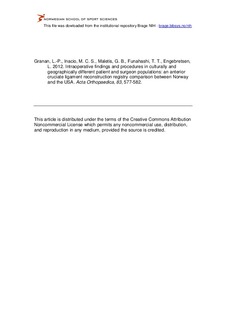| dc.contributor.author | Granan, Lars-Petter | |
| dc.contributor.author | Inacio, Maria C. S. | |
| dc.contributor.author | Maletis, Gregory B. | |
| dc.contributor.author | Funahashi, Tadashi T. | |
| dc.contributor.author | Engebretsen, Lars | |
| dc.date.accessioned | 2013-01-11T12:26:54Z | |
| dc.date.available | 2013-01-11T12:26:54Z | |
| dc.date.issued | 2012-12 | |
| dc.identifier | Seksjon for idrettsmedisinske fag / Department of Sports Medicine | |
| dc.identifier.citation | Acta Orthopaedica. 2012, 83(6), 583-591 | no_NO |
| dc.identifier.issn | 1745-3674 | |
| dc.identifier.uri | http://hdl.handle.net/11250/170994 | |
| dc.description | This article is distributed under the terms of the Creative Commons Attribution Noncommercial License which permits any noncommercial use,
distribution, and reproduction in any medium, provided the source is credited. | no_NO |
| dc.description.abstract | Background and purpose: The association between excessive early migration of acetabular cups and late aseptic revision has been scantily reported. We therefore performed 2 parallel systematic reviews and meta-analyses to determine the association between early migration of acetabular cups and late aseptic revision.
Methods: One review covered early migration data from radiostereometric analysis (RSA) studies, while the other focused on revision rates for aseptic loosening from long-term survival studies. Thresholds for acceptable and unacceptable migration were classified according the Swedish Hip Arthroplasty Register and the Australian National Joint Replacement Registry: < 5% revision at 10 years.
Results: Following an elaborate literature search, 26 studies (involving 700 cups) were included in the RSA review and 49 studies (involving 38,013 cups) were included in the survival review. For every mm increase in 2-year proximal migration, there was a 10% increase in revision rate, which remained after correction for age, sex, diagnosis, hospital type, continent, and study quality. Consequently, proximal migration of up to 0.2 mm was considered acceptable and proximal migration of 1.0 mm or more was considered unacceptable. Cups with proximal migration of between 0.2 and 1.0 mm were considered to be at risk of having revision rates higher than 5% at 10 years.
Interpretation: There was a clinically relevant association between early migration of acetabular cups and late revision due to loosening. The proposed migration thresholds can be implemented in a phased evidence-based introduction, since they allow early detection of high-risk cups while exposing a small number of patients. | no_NO |
| dc.language.iso | eng | no_NO |
| dc.publisher | Informa Healthcare | no_NO |
| dc.subject | age factors | |
| dc.subject | arthroplasty, replacement | |
| dc.subject | follow-up studies | |
| dc.subject | hip prosthesis | |
| dc.subject | incidence | |
| dc.subject | Netherlands | |
| dc.subject | prosthesis design | |
| dc.subject | prosthesis failure | |
| dc.subject | reoperation | |
| dc.subject | risk assessment | |
| dc.subject | sex factors | |
| dc.subject | time factors | |
| dc.subject | treatment outcome | |
| dc.title | Early proximal migration of cups is associated with late revision in THA: a systematic review and meta-analysis of 26 RSA studies and 49 survival studies | no_NO |
| dc.type | Journal article | no_NO |
| dc.type | Peer reviewed | no_NO |
| dc.subject.nsi | VDP::Medical disciplines: 700::Clinical medical disciplines: 750 | no_NO |
| dc.source.pagenumber | 583-591 | no_NO |
| dc.source.volume | 83 | no_NO |
| dc.source.journal | Acta Orthopaedica | no_NO |
| dc.source.issue | 6 | no_NO |
| dc.identifier.doi | 10.3109/17453674.2012.745353 | |
